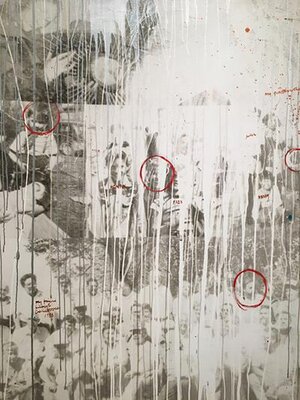Critical Reflections of Works of Art: Carl Beam's Time Dissolve
December 10, 2019
by Emel Thomson, Cohort ’17
The history of an artist’s life is often highly personal and rarely well articulated in their work. Life influences may be reflected in the work but explicit references are rare. Not so with Canadian artist Carl Beam. The Ojibwa artist examines and illustrates the struggle of Aboriginal peoples in the 20th century. There is a sense of urgency to his work, as he reveals the oppression of his people through his personal experiences. In the painting titled “Time Dissolve,” painted in 1992, Beam uses photo emulsion, acrylic and pencil on a large-scale rectangular canvas that is broken into approximately three sections; a kind of vertical triptych (see fig.1).
Hermeneutic Analysis
Naming and identifying people in the painting transforms their position from faded, recessed background images obscured by paint to the “punctum” of the painting. The punctum, a term coined by philosopher Roland Barthes, is an object or image that jumps out at the viewer within a photograph or a painting. The punctum is a detail that attracts you to the image and draws you in. The names and circles painted in red ink emulate the properties of a magnet as the red ink simultaneously pulls the faces in the photograph forward and draws the viewer in for a closer look. The ink also functions as a spotlight that increases visibility of individual people, their connection to the artist, community and their relationship to the whole (see fig.3). The function of words is to name: Fred, Henry, Harry, Molly, Marlene, Peter, Gilbert, Victor, my mother, my grandmother, and my grandfather are identified as people who have special meaning to the artist and to the whole. The names and circles rendered in red ink guides the viewer’s gaze to the middle of the painting where one lingers to take a closer look and move from one face to the next.
The artist retrains the viewer’s eye to subordinate historical knowledge to ontological understanding. The text encourages the viewer to take a closer look at the faces and reflect on their relationship to the artist, their position in the painting and to the community. The viewer also reflects on the symbol of Christianity rendered in the upper image and how Christianity changed the lives of individuals, the community, families, and cultural practices. The text combined with image opens the possibility for an interpretation that achieves a level of understanding that comes through reflection. The personal images of friends, family and aboriginal culture are prioritized and represent approximately 70% of the painting. However, even though partly obscured by white and metallic grey paint that drips and creates vertical lines over the images, the remaining 30% of the canvas illustrates a Christian image that weighs heavily on the whole by its position at the top of the hierarchy of imagery in the painting. This creates an extreme juxtaposition of an iconic Christian image, painted over and positioned against faded photographs of aboriginal culture and beings.
The Christian image appears out of place here and unrelated to the ghostly images of First Nations people, their culture and myths. The direct meaning of the Christian symbol becomes eroded in the painting as other indirect meanings are revealed: “out of place” and “unrelated” unfold as hidden meanings among the relationships of images to the whole (see fig.4).




